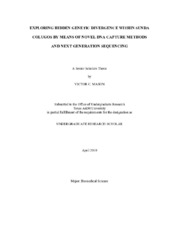| dc.creator | Mason, Victor C | |
| dc.date.accessioned | 2013-04-01T17:11:56Z | |
| dc.date.available | 2013-04-01T17:11:56Z | |
| dc.date.created | 2010-05 | |
| dc.date.issued | 2012-07-11 | |
| dc.date.submitted | May 2010 | |
| dc.identifier.uri | https://hdl.handle.net/1969.1/ETD-TAMU-2010-05-8132 | |
| dc.identifier.uri | https://hdl.handle.net/1969.1/148623 | |
| dc.description.abstract | It has been the goal of biologists to catalog and protect genetic diversity and variation
among biological organisms. The amount of diversity cataloged is growing every year.
In the twelve years between the latest two publications of Mammal Species of the World,
the number of mammalian species increased from 4998 to 5339 (~7%). This number is
expected to increase substantially, especially with the advent and application of new
genomic approaches to assess levels of species diversity. This increased diversity is
partially due to increased taxonomic investigation in Southeast Asia, which is known for
being a hot spot of species richness. This richness has been shown in recent years to be
continually threatened by human induced habitat loss, as is the case of a poorly known
group of mammals, the flying lemurs, or colugos. The colugo is a small arboreal
mammal that inhabits more than fifty islands in the SE Asian archipelago and adjacent
mainland areas of the Malay Peninsula, Thailand and Vietnam. The colugo has
extremely inefficient terrestrial locomotor capabilities, which isolate the colugo to
forested areas, where it is capable of gliding over one hundred meters between trees.
This study proposes a molecular phylogenetic analysis of the Sunda colugo (Galeopterus
variegatus) to redefine the evolutionary relationships between disjunct populations of
this poorly understood mammal, using a novel DNA capture method to isolate degraded
mtDNA fragments from museum samples, by hybridization to DNA fragments derived
from a modern colugo genome. The results demonstrate extremely efficient crossspecies
capture of mtDNA sequences as great as 10-15% divergent from the probe,
combined with Next Generation Sequencing Technologies to obtain high depth of
coverage of hybridized sequences. Phylogenetic results indicate the widespread
presence of species-level taxonomic units both within and between the islands of the
Southeast Asian archipelago. This novel approach to ancient DNA capture has
potentially broad implications for the conservation of this enigmatic mammal, and
further suggest that vicariant evolutionary analysis of colugos will be invaluable for
defining the biogeographic history of the SE Asian archipelago. | en |
| dc.format.mimetype | application/pdf | |
| dc.subject | Biogeography, colugos, archipelago, vicariance | en |
| dc.title | Exploring Hidden Genetic Divergence Within Sunda Colugos by Means of Novel DNA Capture Methods and Next Generation Sequencing | en |
| dc.type | Thesis | en |
| thesis.degree.department | Veterinary Integrative Biosciences | en |
| thesis.degree.discipline | Biomedical Sciences | en |
| thesis.degree.grantor | Honors and Undergraduate Research | en |
| thesis.degree.name | Bachelor of Science | en |
| dc.contributor.committeeMember | Murphy, William J | |
| dc.type.material | text | en |
| dc.date.updated | 2013-04-01T17:11:57Z | |


